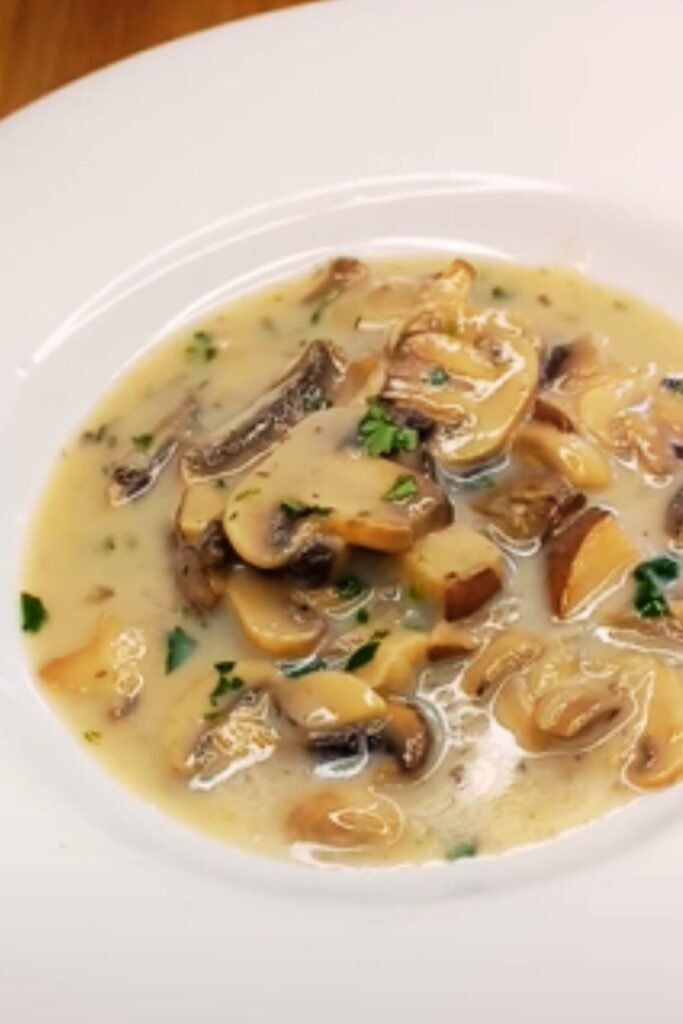There’s something deeply satisfying about a bowl of homemade cream of mushroom soup that the canned variety simply can’t match. I’ve spent years perfecting this recipe, and I’m thrilled to share it with you today. This isn’t just any mushroom soup—it’s a rich, earthy, and complex dish that will have you wondering why you ever settled for the processed version in the first place.
As the weather turns cooler, I find myself craving this comforting soup more and more. The wonderful thing about making it from scratch is the ability to control every aspect of the flavor profile, from the variety of mushrooms to the herbs and seasonings that make it sing. Plus, there’s something almost therapeutic about the process of preparing it—the rhythmic chopping of mushrooms, the fragrant sautéing, and the gentle simmer that fills your kitchen with delicious aromas.
In this article, I’ll guide you through creating a restaurant-quality cream of mushroom soup that balances earthy, umami flavors with velvety creaminess. Whether you’re making it as a starter for a dinner party or as a comforting meal on its own, this recipe is guaranteed to impress.
Ingredients
For the Base Soup:
- 2 pounds (900g) mixed mushrooms (cremini, shiitake, oyster, button)
- 4 tablespoons unsalted butter
- 3 tablespoons olive oil
- 1 large yellow onion, finely diced
- 4 cloves garlic, minced
- 2 tablespoons fresh thyme leaves (or 2 teaspoons dried)
- 1 tablespoon fresh rosemary, finely chopped
- 2 bay leaves
- 1/3 cup all-purpose flour
- 4 cups vegetable broth (or chicken broth for non-vegetarians)
- 1 cup heavy cream
- 1/2 cup dry white wine (optional)
- 1 tablespoon soy sauce or tamari
- 1 teaspoon dijon mustard
- Salt and freshly ground black pepper, to taste
For Garnish:
- 1/4 cup fresh parsley, chopped
- 1/4 cup crispy fried shallots or onions
- Reserved sautéed mushrooms
- Swirl of cream or crème fraîche
- Freshly cracked black pepper
Equipment Needed
| Equipment | Purpose |
|---|---|
| Large Dutch oven or heavy-bottomed pot | For cooking the soup base |
| Sharp chef’s knife | For properly slicing mushrooms and vegetables |
| Wooden spoon | For stirring and scraping fond from pot bottom |
| Immersion blender or countertop blender | For pureeing the soup |
| Measuring cups and spoons | For accurate ingredient measurements |
| Small skillet | For sautéing garnish mushrooms |
| Ladle | For serving |
| Storage containers | For leftovers |
Preparation Time
| Task | Time Required |
|---|---|
| Prep work (cleaning and chopping) | 20 minutes |
| Cooking | 45 minutes |
| Total time | 65 minutes |
| Servings | 6-8 portions |
| Calories per serving | Approximately 320 kcal |
Instructions
Preparing the Mushrooms
The key to an exceptional mushroom soup lies in how you handle the mushrooms themselves. I always follow these steps for maximum flavor:
- Clean the mushrooms by gently wiping with a damp paper towel or soft brush. Avoid soaking them as they absorb water like sponges.
- Remove any tough stems, particularly from shiitake mushrooms.
- Slice most of the mushrooms about 1/4 inch thick, but reserve about 1 cup and chop these into smaller, bite-sized pieces for texture in the finished soup.
- Separate the sliced and chopped mushrooms into two piles.
Creating the Perfect Base
- In your Dutch oven or heavy pot, melt 2 tablespoons of butter with 2 tablespoons of olive oil over medium-high heat.
- When the butter is foaming, add about 3/4 of your sliced mushrooms (not the chopped ones yet). Important: Don’t overcrowd the pan, work in batches if necessary.
- Allow the mushrooms to cook undisturbed for 3-4 minutes until they begin to brown on one side.
- Stir and continue cooking for another 3-4 minutes until golden brown all over.
- Remove this batch and set aside.
- Add 1 more tablespoon each of butter and oil to the pot.
- Add the onions and cook for 5-7 minutes until translucent and just beginning to caramelize.
- Add the garlic, thyme, and rosemary, cooking for another 1-2 minutes until fragrant.
- Add the remaining sliced mushrooms and the chopped mushrooms, cooking for 5 minutes until they release their moisture.
- Season with salt and pepper.
Building the Soup
- Sprinkle the flour over the mushroom mixture and stir continuously for 2 minutes to cook out the raw flour taste.
- If using wine, add it now and scrape up any browned bits from the bottom of the pot. Allow the wine to reduce by half, about 3 minutes.
- Slowly add the broth, stirring constantly to avoid lumps.
- Add the bay leaves and bring to a simmer.
- Reduce heat to low-medium and let simmer for 20 minutes, stirring occasionally.
- Remove the bay leaves.
- Add the soy sauce and dijon mustard, stirring to incorporate.
Finishing the Soup
- For a smoother soup: Use an immersion blender to partially blend the soup, leaving some texture. Alternatively, transfer about 2/3 of the soup to a blender, puree, and return to the pot.
- Add the heavy cream and stir to incorporate.
- Return 2/3 of the reserved sautéed mushrooms to the soup.
- Taste and adjust seasoning with salt and pepper.
- Heat gently for another 5 minutes, being careful not to boil.

Mushroom Varieties and Their Flavor Profiles
Understanding the different mushrooms you can use will help you customize this soup to your preferences:
| Mushroom Type | Flavor Profile | Best Used For |
|---|---|---|
| Cremini (Baby Bella) | Earthy, meaty, deeper than button | Base flavor, good all-purpose mushroom |
| Button (White) | Mild, slightly earthy | Bulk and texture |
| Shiitake | Rich, smoky, umami | Adding complexity and depth |
| Oyster | Delicate, subtle anise notes | Adding sophistication |
| Porcini (dried) | Intensely woodsy, nutty | Rehydrate and add to broth for extreme depth |
| Chanterelle | Fruity, peppery | Special occasions, delicate flavor |
| Portobello | Meaty, robust | When you want a “beefy” quality |
I recommend using at least two varieties in your soup. My personal favorite combination is cremini as the base with shiitake for depth and a few oyster mushrooms for complexity.
Secret Techniques for Maximum Flavor
After years of perfecting this recipe, I’ve discovered several techniques that elevate a good mushroom soup to an exceptional one:
- Don’t wash mushrooms if possible – Wipe with a damp cloth instead. Mushrooms are porous and absorb water, which dilutes their flavor.
- Brown, don’t steam – Give mushrooms plenty of space in the pan and let them brown properly before stirring. This develops the crucial Maillard reaction that creates complex flavors.
- Save some mushrooms for texture – By reserving some sautéed mushrooms to add back at the end, you get textural contrast and concentrated mushroom flavor in every bite.
- Use umami boosters – The soy sauce and dijon mustard might seem unusual, but they enhance the natural umami of mushrooms without making the soup taste like either ingredient.
- Let it rest – Like many soups, cream of mushroom actually improves after sitting for a few hours or overnight as the flavors meld together.

Serving Suggestions
This soup is versatile enough to be served in multiple ways:
- As an elegant starter in small portions with a garnish of reserved sautéed mushrooms and a swirl of cream
- As a main course with crusty artisan bread for dipping
- Alongside a crisp green salad with a bright vinaigrette to balance the soup’s richness
- In a bread bowl for an impressive presentation
- As a sauce over pasta, chicken, or pork chops (use a slightly thicker version)
- As the base for a green bean casserole that will outshine any made with canned soup
For garnishing, I like to offer:
- Fresh herbs (parsley, chives, or thyme)
- A swirl of cream or crème fraîche
- Crispy fried shallots or onions
- Garlic croutons
- A few drops of truffle oil for special occasions
- Crumbled bacon for non-vegetarians
Dietary Adaptations
This soup can be easily modified for various dietary needs:
Vegetarian/Vegan Version
- Use vegetable broth instead of chicken broth
- For vegan: Replace butter with olive oil or plant-based butter
- For vegan: Substitute heavy cream with full-fat coconut milk or cashew cream
- Ensure your soy sauce is vegan-friendly
Gluten-Free Version
- Replace all-purpose flour with cornstarch slurry (2 tablespoons cornstarch mixed with 1/4 cup cold water)
- Use gluten-free tamari instead of soy sauce
- Verify your broth is gluten-free
Lower-Fat Version
- Use half-and-half instead of heavy cream
- Reduce butter and increase olive oil proportion
- Use an immersion blender to create creaminess without as much added fat
Dairy-Free Version
- Replace butter with olive oil or plant-based butter
- Use coconut cream or cashew cream instead of heavy cream
Storage and Reheating
| Storage Method | Duration | Notes |
|---|---|---|
| Refrigerator | 3-4 days | Store in airtight container |
| Freezer | Up to 3 months | Freeze before adding cream; add when reheating |
| Reheating | Low heat | Stir frequently; may need additional broth |
When reheating this soup, do so gently over low heat, stirring frequently to prevent the cream from separating. If the soup becomes too thick after refrigeration, thin it with a little broth or water to reach your desired consistency.

Troubleshooting Common Issues
| Problem | Possible Cause | Solution |
|---|---|---|
| Soup is too thin | Not enough flour/thickener | Simmer longer to reduce, or create a beurre manié (equal parts softened butter and flour kneaded together) and whisk in small amounts |
| Soup is too thick | Too much flour or reduction | Add additional broth gradually until desired consistency is reached |
| Grainy texture | Cream curdled from high heat | Lower heat immediately, whisk in a bit of cold cream |
| Bland flavor | Insufficient seasoning or mushroom variety | Add umami boosters like soy sauce, more salt, or a dash of fish sauce |
| Flour taste | Raw flour not cooked long enough | Next time, cook roux longer before adding liquids |
Seasonal Variations
While this soup is perfect for fall and winter, you can adapt it seasonally:
Spring
- Add fresh peas and a touch of lemon zest
- Garnish with tender herbs like chervil and spring onions
Summer
- Make it lighter by using half-and-half instead of cream
- Serve chilled with a drizzle of herb oil
Fall
- Add roasted butternut squash pieces
- Include warming spices like nutmeg and a pinch of clove
Winter
- Add root vegetables like parsnips for heartiness
- Finish with a splash of cognac or sherry for warmth
Health Benefits of Mushrooms
Beyond being delicious, this soup provides numerous health benefits from its star ingredient:
| Nutrient | Benefit |
|---|---|
| Beta-glucans | Immune system support |
| Selenium | Antioxidant protection |
| Vitamin D (in sun-exposed mushrooms) | Bone health and immune function |
| B vitamins | Energy production and nervous system health |
| Potassium | Heart health and fluid balance |
| Fiber | Digestive health |
Mushrooms are one of the few non-animal food sources that naturally contain vitamin D, especially when they’ve been exposed to sunlight. They’re also low in calories while providing satisfying umami flavor, making this soup both nutritious and satisfying.
Q&A Section
Q: Can I make this soup ahead of time for a dinner party? A: Absolutely! In fact, I recommend making it a day ahead. The flavor actually improves as it sits overnight in the refrigerator. Just reheat gently and add the garnishes fresh before serving.
Q: I don’t have fresh herbs. Can I use dried? A: Yes, but use about 1/3 of the amount called for fresh herbs. So instead of 2 tablespoons fresh thyme, use 2 teaspoons dried. Add them at the same point in the recipe.
Q: How can I make this soup even more luxurious for a special occasion? A: There are several ways to elevate this soup: add a tablespoon of truffle butter at the end, incorporate a few rehydrated dried porcini mushrooms and their soaking liquid, or finish each serving with a few drops of white truffle oil and a sprinkle of chives.
Q: Can I use this homemade soup in recipes that call for condensed cream of mushroom soup? A: Yes! To substitute for condensed soup, reduce this recipe by simmering it longer until it reaches a very thick consistency. You may need to add a bit more flour during the cooking process to achieve the right thickness.
Q: My family doesn’t like visible mushroom pieces. Can I make this completely smooth? A: Certainly. After cooking the mushrooms and before adding the cream, puree the entire soup in batches in a blender until completely smooth. Return to the pot, add the cream, and proceed with the recipe.
Q: Can I make this in a slow cooker? A: Yes, but you’ll still want to sauté the mushrooms, onions, and garlic on the stovetop first to develop those important flavors. Transfer to a slow cooker, add the broth and herbs, and cook on low for 4-6 hours. Add the cream during the last 30 minutes of cooking.
Q: I’m trying to reduce calories. What’s the best way to make this lighter? A: The easiest substitution is to use half-and-half or whole milk instead of heavy cream. You can also reduce the amount of butter used for sautéing and use more olive oil instead. The soup won’t be quite as rich but will still be delicious.
Q: Can this soup be made vegetarian/vegan? A: Yes! Use vegetable broth instead of chicken broth for vegetarian. For vegan, also substitute the butter with olive oil or plant-based butter, and replace the heavy cream with full-fat coconut milk or cashew cream.
Q: What mushrooms work best if I can only use one type? A: If you’re limited to one variety, cremini (baby bella) mushrooms offer the best flavor for this soup. They have more depth than button mushrooms but are widely available and reasonably priced.
Q: Why does my soup sometimes curdle when I add the cream? A: Curdling happens when cream is added to a very hot liquid. To prevent this, take the soup off the heat for a minute before adding the cream, or temper the cream by gradually adding a little hot soup to it before incorporating it into the pot. Also, never let the soup boil after adding cream.
Final Thoughts
Creating a truly exceptional cream of mushroom soup is an exercise in patience and attention to detail. The time invested in properly browning the mushrooms, developing the base flavors, and carefully incorporating the cream results in a soup that’s worlds apart from anything you can pour from a can.
I find that this soup has become something of a signature dish in my home—one that friends and family request regularly. It’s perfect for those days when you want something that feels both nourishing and a bit luxurious.
Remember, the quality of your ingredients matters significantly in a recipe with so few components. Use the freshest mushrooms you can find, real cream, and good butter. The difference is noticeable in the final dish.
I hope you enjoy making and sharing this soup as much as I do. There’s something special about ladling a homemade cream of mushroom soup into bowls on a chilly evening, watching the steam rise, and knowing that you’ve created something truly delicious from scratch.



